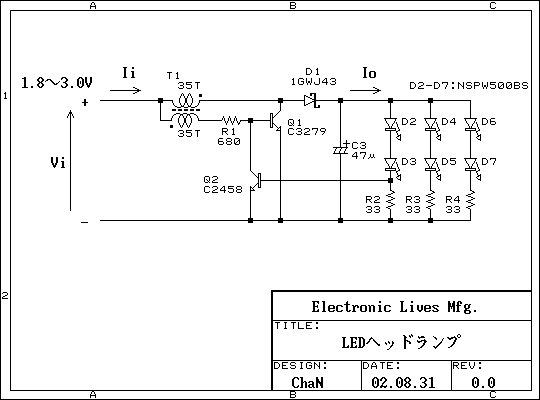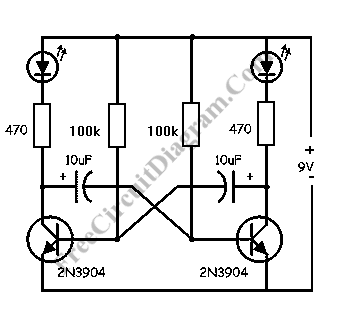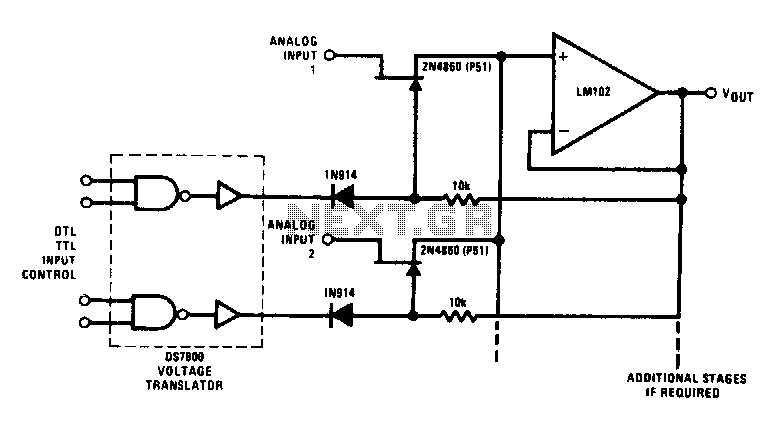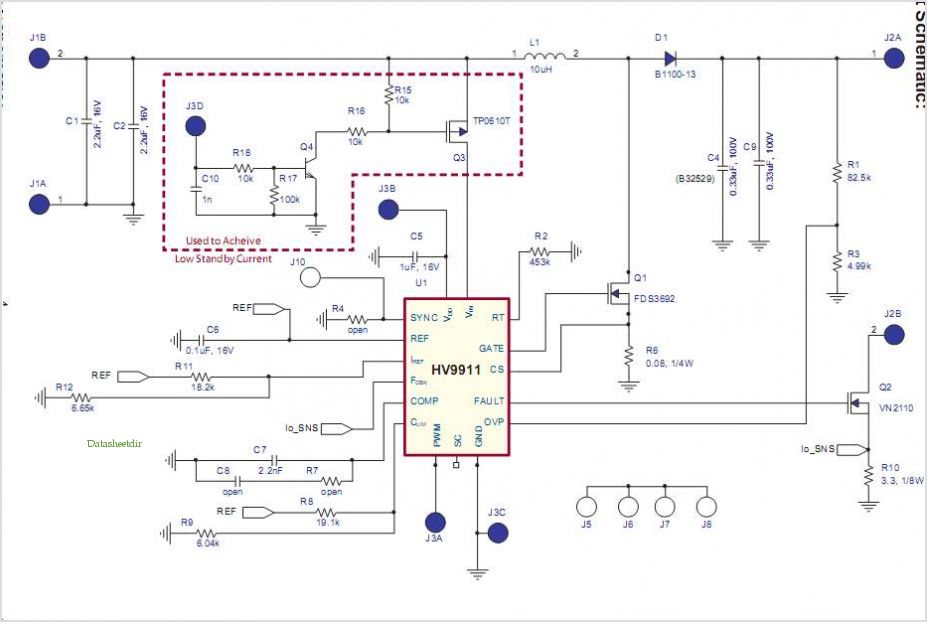
White LED Head Lamp

This is a practical white LED head mount lamp (flashlight). Recently many white LED flashlights appear on the market. However, most flashlights require three cells because they are regulating output current with only series resistor. The odd number of cells except one is not good, and a margin between VLED and VBAT is too small, intensity of light is affected by variation of input voltage within the battery life. Thus I built a white LED head lamp which operates with two cells and controls output current.
The described white LED head mount lamp utilizes a two-cell configuration to enhance efficiency and performance. The circuit is designed to regulate the output current effectively, ensuring consistent brightness regardless of battery voltage fluctuations. This is achieved through the use of a constant current driver circuit, which maintains the LED's forward current within specified limits, preventing variations in light intensity.
In this schematic, the two cells, typically lithium-ion or alkaline, are connected in series to provide a nominal voltage of approximately 3V to 3.7V. The LED is connected to the output of a current regulator, which can be implemented using an integrated circuit (IC) such as the LM317 configured as a constant current source, or a dedicated LED driver IC.
The current regulator circuit includes a feedback loop that monitors the voltage across a sensing resistor placed in series with the LED. This feedback mechanism allows the circuit to adjust the output to maintain a stable current, compensating for changes in the battery voltage as it discharges.
Additional components may include capacitors for filtering and stability, as well as a diode for reverse polarity protection to safeguard against incorrect battery installation. A switch can be included to control the operation of the lamp, allowing the user to turn it on or off as needed.
Thermal management is also an important consideration; thus, the LED should be mounted on a suitable heat sink to dissipate heat effectively, ensuring longevity and reliability of the light source. The overall design emphasizes compactness and portability, making it suitable for head mount applications while providing sufficient illumination for various tasks.
This innovative approach provides a practical solution for users seeking a reliable and efficient white LED head mount lamp that operates effectively with a two-cell configuration, addressing the common limitations found in traditional flashlight designs.This is a practical white LED head mount lamp (flashlight). Recently many white LED flashlights appear on the market. However, most flashlights require three cells because they are regurating output current with only series resister. The odd number of cells except one is not good, and a margin between VLED and VBAT is too small, intensity of light is affected by variation of input voltage within the battery life.
Thus I built a white LED head lamp which operates with two cells and controls output current. 🔗 External reference
The described white LED head mount lamp utilizes a two-cell configuration to enhance efficiency and performance. The circuit is designed to regulate the output current effectively, ensuring consistent brightness regardless of battery voltage fluctuations. This is achieved through the use of a constant current driver circuit, which maintains the LED's forward current within specified limits, preventing variations in light intensity.
In this schematic, the two cells, typically lithium-ion or alkaline, are connected in series to provide a nominal voltage of approximately 3V to 3.7V. The LED is connected to the output of a current regulator, which can be implemented using an integrated circuit (IC) such as the LM317 configured as a constant current source, or a dedicated LED driver IC.
The current regulator circuit includes a feedback loop that monitors the voltage across a sensing resistor placed in series with the LED. This feedback mechanism allows the circuit to adjust the output to maintain a stable current, compensating for changes in the battery voltage as it discharges.
Additional components may include capacitors for filtering and stability, as well as a diode for reverse polarity protection to safeguard against incorrect battery installation. A switch can be included to control the operation of the lamp, allowing the user to turn it on or off as needed.
Thermal management is also an important consideration; thus, the LED should be mounted on a suitable heat sink to dissipate heat effectively, ensuring longevity and reliability of the light source. The overall design emphasizes compactness and portability, making it suitable for head mount applications while providing sufficient illumination for various tasks.
This innovative approach provides a practical solution for users seeking a reliable and efficient white LED head mount lamp that operates effectively with a two-cell configuration, addressing the common limitations found in traditional flashlight designs.This is a practical white LED head mount lamp (flashlight). Recently many white LED flashlights appear on the market. However, most flashlights require three cells because they are regurating output current with only series resister. The odd number of cells except one is not good, and a margin between VLED and VBAT is too small, intensity of light is affected by variation of input voltage within the battery life.
Thus I built a white LED head lamp which operates with two cells and controls output current. 🔗 External reference





